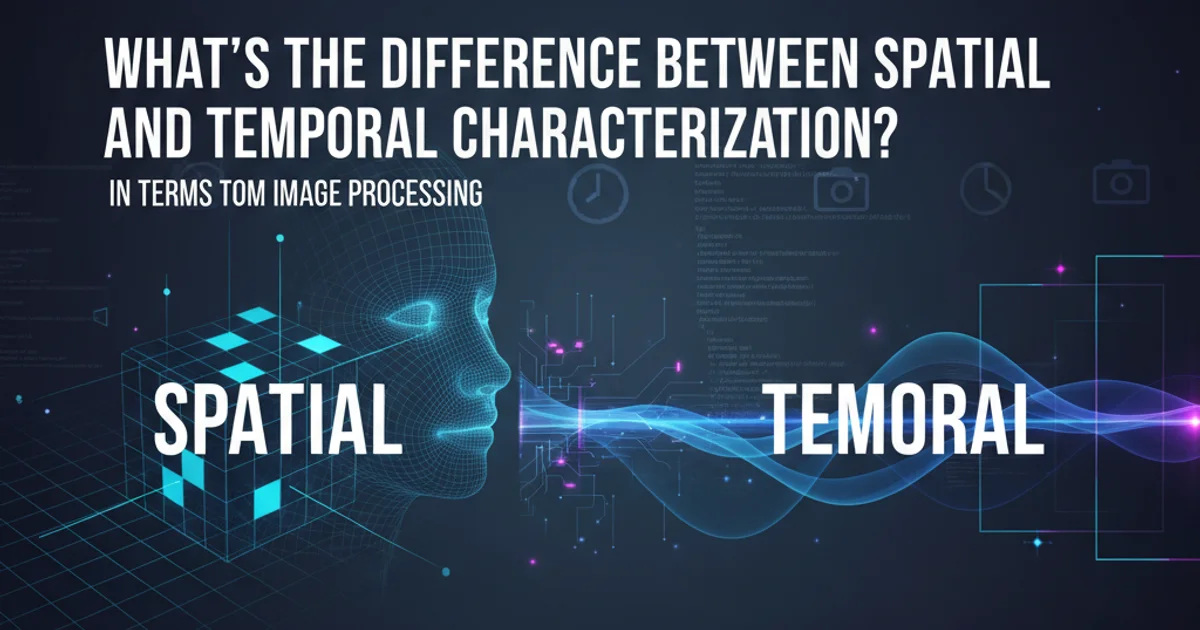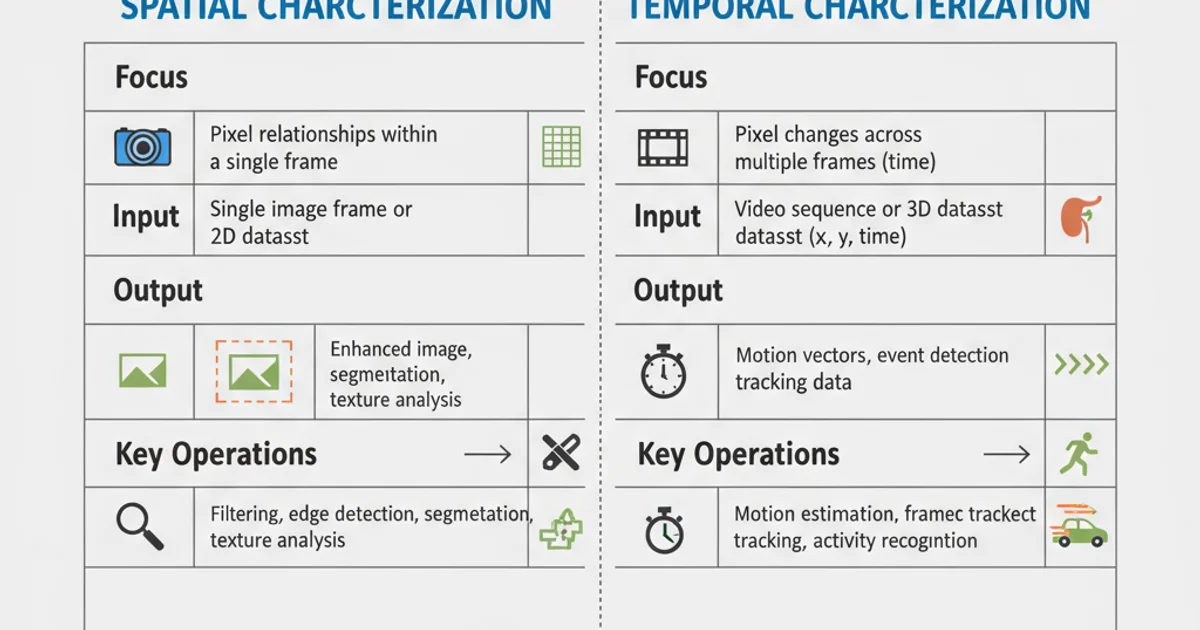what's the difference between spatial and temporal characterization in terms of image processing?
Categories:
Spatial vs. Temporal Characterization in Image Processing

Explore the fundamental differences between spatial and temporal characterization in image processing, understanding their applications, techniques, and how they contribute to analyzing visual data.
Image processing involves a wide array of techniques to analyze, manipulate, and enhance visual data. A crucial aspect of this analysis is understanding how information is characterized, primarily through spatial and temporal dimensions. While both are fundamental to interpreting images and video, they focus on distinct aspects of the visual information. This article delves into the core differences, applications, and methodologies of spatial and temporal characterization in image processing.
Understanding Spatial Characterization
Spatial characterization refers to the analysis of an image at a single point in time, focusing on the relationships between pixels within that specific frame. It deals with the arrangement, intensity, color, and texture of pixels across the 2D (or 3D for volumetric data) plane. The goal is to extract features, patterns, and structures that define the objects and regions within the image.
Key aspects of spatial characterization include:
- Feature Extraction: Identifying edges, corners, blobs, and other distinctive points or regions.
- Segmentation: Dividing an image into multiple segments or regions, often to isolate objects of interest.
- Texture Analysis: Describing the visual patterns of surfaces, such as smoothness, coarseness, or regularity.
- Shape Analysis: Quantifying the geometric properties of objects, like area, perimeter, and aspect ratio.
- Color Analysis: Examining color distributions, histograms, and color spaces to understand image content.
flowchart TD
A[Input Image (Single Frame)] --> B{Spatial Filtering}
B --> C{Edge Detection}
C --> D{Feature Extraction}
D --> E{Segmentation}
E --> F[Object Recognition/Analysis]
B --> G{Texture Analysis}
G --> FTypical workflow for spatial characterization in image processing.
import cv2
import matplotlib.pyplot as plt
# Load an image
image = cv2.imread('example_image.jpg', cv2.IMREAD_GRAYSCALE)
# Apply a spatial filter (Gaussian blur for smoothing)
blurred_image = cv2.GaussianBlur(image, (5, 5), 0)
# Perform edge detection (Canny)
edges = cv2.Canny(blurred_image, 100, 200)
plt.figure(figsize=(10, 5))
plt.subplot(1, 3, 1), plt.imshow(image, cmap='gray'), plt.title('Original Image')
plt.subplot(1, 3, 2), plt.imshow(blurred_image, cmap='gray'), plt.title('Blurred Image')
plt.subplot(1, 3, 3), plt.imshow(edges, cmap='gray'), plt.title('Edges (Canny)')
plt.show()
Python example demonstrating spatial filtering and edge detection using OpenCV.
Understanding Temporal Characterization
Temporal characterization, in contrast, focuses on how image content changes over time. This is primarily relevant for video sequences or time-series image data. It involves analyzing the differences between consecutive frames to detect motion, track objects, or identify events. The 'time' dimension adds another layer of complexity and information to the analysis.
Key aspects of temporal characterization include:
- Motion Detection: Identifying regions where pixel values have changed significantly between frames, indicating movement.
- Object Tracking: Following the trajectory of specific objects across a sequence of frames.
- Activity Recognition: Interpreting sequences of motion to understand actions or behaviors.
- Frame Differencing: A basic technique to highlight changes between two frames.
- Optical Flow: Estimating the apparent motion of objects, surfaces, and edges in a visual scene caused by the relative motion between the observer and the scene.
sequenceDiagram
participant Frame_t as Frame (t)
participant Frame_t_plus_1 as Frame (t+1)
Frame_t->>Frame_t_plus_1: Capture
Frame_t_plus_1->>Processor: Compare Frames
Processor->>Processor: Calculate Pixel Differences
Processor->>Processor: Apply Thresholding
Processor->>Output: Detect Motion/Changes
Processor->>Tracker: Update Object Position
Tracker->>Output: Track Object TrajectorySequence diagram illustrating a basic temporal characterization process for motion detection.
import org.opencv.core.Core;
import org.opencv.core.Mat;
import org.opencv.core.Scalar;
import org.opencv.imgcodecs.Imgcodecs;
import org.opencv.imgproc.Imgproc;
public class TemporalDiff {
static {
System.loadLibrary(Core.NATIVE_LIBRARY_NAME);
}
public static void main(String[] args) {
Mat frame1 = Imgcodecs.imread("frame_t.jpg", Imgcodecs.IMREAD_GRAYSCALE);
Mat frame2 = Imgcodecs.imread("frame_t_plus_1.jpg", Imgcodecs.IMREAD_GRAYSCALE);
if (frame1.empty() || frame2.empty()) {
System.out.println("Could not load images.");
return;
}
Mat diff = new Mat();
Core.absdiff(frame1, frame2, diff);
Mat thresholdedDiff = new Mat();
Imgproc.threshold(diff, thresholdedDiff, 30, 255, Imgproc.THRESH_BINARY);
Imgcodecs.imwrite("motion_detected.jpg", thresholdedDiff);
System.out.println("Motion detection complete. See motion_detected.jpg");
}
}
Java example using OpenCV for basic frame differencing to detect motion.
Key Differences and Applications
The fundamental distinction lies in their focus: spatial characterization looks at 'what' is in a single image, while temporal characterization looks at 'how' things change across a sequence of images. This leads to distinct applications:

Comparison of Spatial vs. Temporal Characterization
Understanding these differences is crucial for selecting the appropriate algorithms and approaches for a given image or video analysis task. A static image analysis will heavily rely on spatial techniques, whereas surveillance footage or medical imaging over time will necessitate temporal methods.